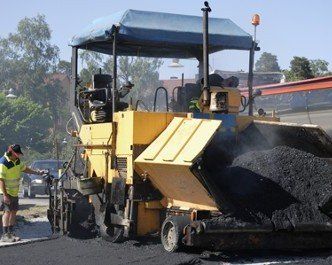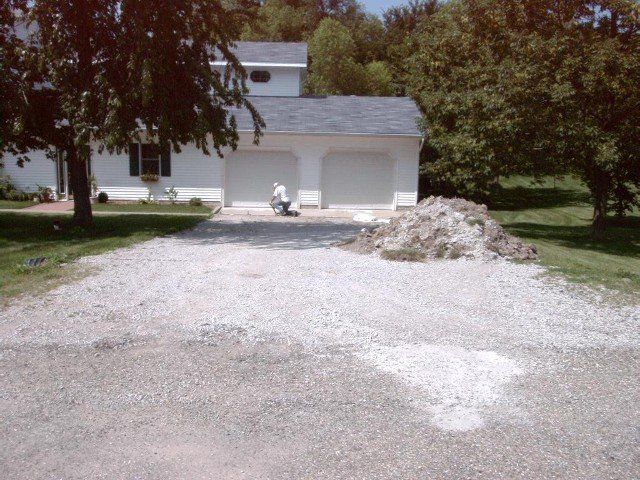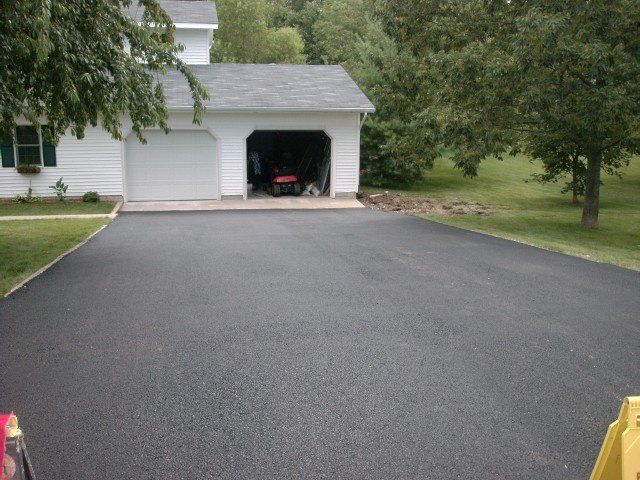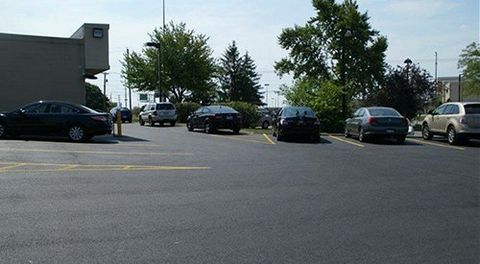
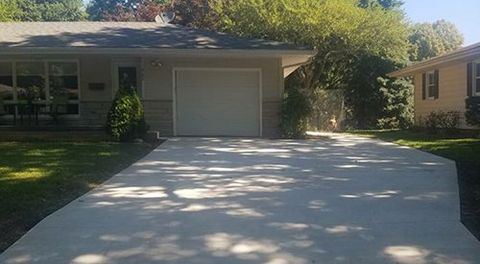
Custom Asphalt Services in Bloomington, Illinois
New Construction
As the name implies, new construction is the building of new asphalt surfaces. First, excavation and grading of the area are performed as necessary to establish desired grade and drainage. Next, an aggregated base course (ABC) is placed and compacted. Finally asphalt mix is applied to present a finished base.
Removal & Replacement of Existing Asphalt
Deterioration of asphalt can occur as a result of lack of maintenance, overuse, or simply living past its life expectancy. In such cases, old asphalt pavement may need
to be removed and replaced or refurbished with one of the following options:
Regular Overlay - When an asphalt pavement surface deteriorates to the point of needing repair, an asphalt overlay is an effective solution. A standard asphalt overlay consists of a new layer of asphalt applied over the existing asphalt surface. The thickness of an overlay is typically 1 1/2 to 2 inches, but type and amount of traffic, as well as individual customer needs, are also considered.
to be removed and replaced or refurbished with one of the following options:
Regular Overlay - When an asphalt pavement surface deteriorates to the point of needing repair, an asphalt overlay is an effective solution. A standard asphalt overlay consists of a new layer of asphalt applied over the existing asphalt surface. The thickness of an overlay is typically 1 1/2 to 2 inches, but type and amount of traffic, as well as individual customer needs, are also considered.
The Existing Asphalt Surface -
The existing surface may be milled if grades need to be maintained or altered. Milling is a process by which a machine is used to plane the pavement surface to an appropriate depth before it is covered with the new layer. Once the milling is finished and the overlay is complete, the customer is left with a brand new surface ready for pavement marking.
Complete Removal and Replacement - Severe subgrade deficiencies may require complete removal of part or all of the pavement and base material. After excavation and removal, pre-existing conditions in the subgrade such as excess moisture, shallow utility lines, missing aggregate base, or incorrectly prepared subgrade may require additional steps in the base preparation. These conditions are usually not discovered until the overlying asphalt is removed. After careful inspection, your Marshall Asphalt representative can recommend the most effective methods to resolve these conditions. When pre-existing conditions have been corrected, new aggregate is supplied as needed and recompacted with vibratory rollers. Then the new asphalt can be laid.
Complete Removal and Replacement - Severe subgrade deficiencies may require complete removal of part or all of the pavement and base material. After excavation and removal, pre-existing conditions in the subgrade such as excess moisture, shallow utility lines, missing aggregate base, or incorrectly prepared subgrade may require additional steps in the base preparation. These conditions are usually not discovered until the overlying asphalt is removed. After careful inspection, your Marshall Asphalt representative can recommend the most effective methods to resolve these conditions. When pre-existing conditions have been corrected, new aggregate is supplied as needed and recompacted with vibratory rollers. Then the new asphalt can be laid.
Asphalt Patching
The best way to protect the investment in your asphalt pavement is to be diligent about "preventative" maintenance, such as crack filling and seal coating. But once asphalt decay has advanced past the stage where these are an appropriate remedy, it is necessary for a "reactionary" remedy. Asphalt patching is necessary for areas that are heavily cracked (or "alligatored"), sunken, exposed (potholes) or raised by roots or water damage.
The perimeter of the affected area will be sawcut to provide a clean, professional-looking edge and to provide maximum structural integrity. The old, decayed asphalt will be removed and disposed of. The subgrade will be inspected and appropriate action will be taken (such as clipping tree roots, bringing new crushed rock, or providing new compaction). New hot mix will then be placed and compacted. Tar seal is applied to the seams (of old adjacent to new) to prevent moisture penetration. As a general standard, asphalt thickness of 2-inches is appropriate. Areas that have high traffic volume or very heavy trucks may require a greater thickness.
The perimeter of the affected area will be sawcut to provide a clean, professional-looking edge and to provide maximum structural integrity. The old, decayed asphalt will be removed and disposed of. The subgrade will be inspected and appropriate action will be taken (such as clipping tree roots, bringing new crushed rock, or providing new compaction). New hot mix will then be placed and compacted. Tar seal is applied to the seams (of old adjacent to new) to prevent moisture penetration. As a general standard, asphalt thickness of 2-inches is appropriate. Areas that have high traffic volume or very heavy trucks may require a greater thickness.
Contact us for services that give your property curb appeal.
SHARE THIS PAGE:

